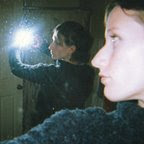As I drew the sketches of the cells that will go into my Flash site and began working in Illustrator to make them into vector art, I had a few ideas about a technique to help speed things along. Here, I want to share a tutorial on making custom brushes in Illustrator. Specifically, the ribosomes typically appear, at a scale of 10,000X, to be small 1pt dots, distributed throughout the cytoplasm or attached to the rough endoplasmic reticulum. This brush will create a regular pattern of dots that follow the path of the brush.
- Make a 1pt dot using the ellipse tool.
- Convert it to a symbol by selecting it, and going to the menu inside the symbols tab, and click "new symbol."
- With the dot selected as the symbol, use the symbol sprayer to spray a bunch of dots out. Make it look natural and not too regular or patterned.
- Select the field of dots and go to Object > Expand. The default will have "object" and "fill" selected, which is fine: say OK.
- Remove any unwanted dots. It's probably a good idea to keep them within a square area to avoid a stamped look later. Individual dots can now be moved around to your liking.
- With your square of dots selected, enter the menu of the brushes tab and select "new brush."
- You will have 4 options. The first, New Calligraphic Brush, doesn't allow you to use the pattern, so forget about this one.
- New Scatter Brush - this option will create a brush that will repeat the selected pattern exactly without any distortion. The number of repeats is based on the length of the path, but it will be no fewer than one stamp of it (i.e. it will not be shrunk or cut in half). Thus it is a good option for this purpose, as long as the path is straight. Otherwise you get a tiled, stamped look. It just happens to be the first thing I tried, and it works, but lets have a look at the other choices, just out of curiosity.
- New Art Brush - Takes the pattern of dots and stretches it out to fit the path. This causes distortion and differences in the size and shape of the dots. Hence, it is not a good option for this purpose.
- New Pattern Brush - creates a brush that is like a cross between the scatter and art brushes, in that it repeats the pattern and conforms it to the path with minimal (but still present) distortion. So, not a terrible option for our purposes.
Now after I have drawn the cell's outline and other organelles, I can use brushes made in this way to distribute ribosomes throughout the cell in a fraction of the time it would have taken me to paste or draw them in, and with more predictability than I would have had by using the symbol sprayer. Next I hope to make a brush that can automate the drawing of the endoplasmic reticulum and golgi apparatus, which typically appear in cross-section as a series of flattened sacs or elongated ovals.

Dear Kristin - I'm so glad you posted about the pattern brush. I needed something like this today and thanks to your post I knew how to go about it. I'm Glad to see your interactive progresssing. Hope all is well. best wishes, Evelyn M.
ReplyDelete